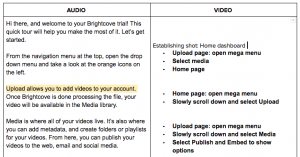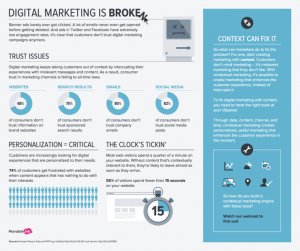by Jack Loechner, Staff Writer @mp_research, June 24, 2016
According to Evergage and Researchscape International, the new annual study on the State Of Personalization found that 85% of companies are now implementing some form of personalization. However, most companies’ personalization initiatives barely make the grade, with the majority of marketers (55%) giving their own, and their competitors’ (63%), efforts a grade of “C” or lower.
When it comes to the importance of the marketing initiatives that organizations are implementing, search engine optimization (SEO) is “very” or “extremely” important to 79% of respondents, closely followed by email marketing and content marketing (78% and 75% respectively) and personalization (74%).
55% of respondents from organizations that are not implementing any personalization yet, plan to use website or in-app personalization (web or mobile) within the next year. Of those already using personalization, 89% report an improvement or “lift”, and of those, 53% have seen a lift of 10% or more, relying most heavily on personalized messages or experiences in inline content and information bar, says the report.
Search engine optimization (SEO) is very or extremely important to 79% of responding organizations implementing, closely followed by email marketing and content marketing and personalization of all types.
Marketing Initiatives In Order Of Importance For Your Organization | ||
Marketing Initiative |
Very Important |
Extremely Important |
Search engine optimization SEO |
42% |
37% |
Customer loyalty |
33 |
41 |
Email marketing |
43 |
35 |
Personalization |
40 |
34 |
Content marketing |
41 |
34 |
Adwords/PPC |
45 |
28 |
Mobile marketing |
31 |
35 |
Social Media Communications |
33 |
22 |
Source: Engage/ResearchScape International, June 2016 | ||
A majority of organizations surveyed are personalizing email and their website. Only 27% are personalizing their mobile website. Mobile and web applications are the least selected channel for personalization.
Use of Personalization | |
Personalization Utilization |
% of Respondents |
67% | |
Website |
56 |
Mobile website |
27 |
Mobile app |
20 |
Web application |
19 |
None of the above |
15 |
Source: Engage/ResearchScape International, June 2016 | |
The two most-used types of personalized messages are inline content (text or images inserted dynamically within the page content) and information bars (messages across top or bottom of page.) Only 12% of respondents don’t use any of the listed personalization message types.
Types Of Personalized Messages Or Experiences Used (All That Apply) | |
Content |
% Using |
Inline content |
53% |
Information bars |
48 |
Pop-ups |
42 |
Call-outs |
40 |
Inline edits |
34 |
Survey questions |
33 |
Other |
4 |
None of above |
8 |
Source: Engage/ResearchScape International, June 2016 | |
The majority of respondents using website/in-app personalization realize the following benefits:
- An increase in conversion rates (65%)
- Increased visitor engagement (62%)
- Improved customer experience (61%)
- 46% and 45% respectively see increased lead generation and customer acquisition
- 36% reported increases in customer lifetime value/loyalty
The greatest obstacle to making real-time personalization a bigger priority in the respondents’ organizations is the lack of budget, with lack of personnel a close second. Lack of knowledge/skills is the third most common obstacle, says the report.
The Greatest Obstacles To Making Website/In-App Personalization A Bigger Priority In Organization? (All That Apply) | |
Obstacle |
% of Responses |
Lack of budget |
59% |
Lack of personnel |
50 |
Lack of knowledge/skills |
48 |
IT department constraints |
29 |
Poor technology solutions |
21 |
Lack of business case |
20 |
Access to data |
19 |
Lack of executive sponsorship |
18 |
Too many technology solutions |
17 |
Company culture |
14 |
Source: Engage/ResearchScape International, June 2016 | |
The report from Evergage is available with sign-in here.
MediaPost.com: Search Marketing Daily
(30)
Report Post



